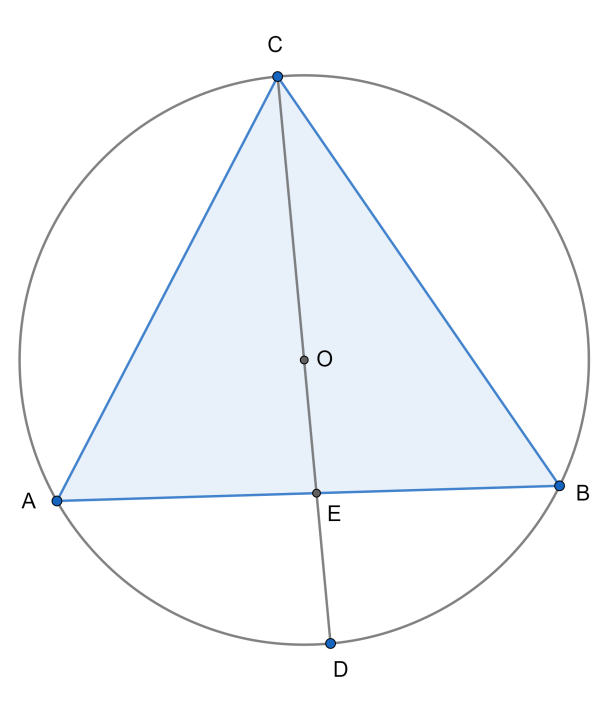
Answer
437.1k+ views
Hint: To do this question, we will first consider the two triangles formed in the triangle $\Delta ABC$, $\Delta ACE$ and $\Delta BCE$. Then we will try to prove these two triangles as congruent triangles. Then, as both these triangles will be congruent, we can say that the sides AC and BC are equal by the rule of CPCT. Thus, as two sides of a triangle will be equal, the triangle $\Delta ABC$ will be an isosceles triangle.
Complete step by step answer:
Here, we have been given the following figure:

In this figure, we have to prove that $\Delta ABC$ is an isosceles triangle.
For that, let us consider $\Delta ACE$ and $\Delta BCE$.
We can see in these two triangles that:
CE = CE (as CE is a common side to both the triangles)
$\angle AEC=\angle BEC={{90}^{\circ }}$ (as it has been given to us that the diameter CD is perpendicular to the chord AB at E)
AE = EB (we know that perpendicular from the centre to any chord of a triangle bisects the chord)
Thus, we can say that $\Delta ACE\cong \Delta BCE$ by the SAS (side angle side) criteria.
Hence, by applying CPCT (corresponding parts of congruent triangles) in these triangles, we can say that:
AC = BC
Thus, since two sides of the triangle $\Delta ABC$ are equal (AC and BC), we can say that the triangle $\Delta ABC$ is an isosceles triangle.
Hence, proved.
Note:
There are certain properties of a circle that might come in handy. They are given as follows:
1. Perpendicular on a chord from the circle always bisects the chord.
2. The line from the centre bisecting the chord is perpendicular to the chord.
3. Angle in a semicircle is ${{90}^{\circ }}$.
4. Angle subtended by any chord at the centre is double the angle subtended by that chord at any other point of the circle.
5. Angles subtended by the same chord at different points of the circles are equal.
Complete step by step answer:
Here, we have been given the following figure:

In this figure, we have to prove that $\Delta ABC$ is an isosceles triangle.
For that, let us consider $\Delta ACE$ and $\Delta BCE$.
We can see in these two triangles that:
CE = CE (as CE is a common side to both the triangles)
$\angle AEC=\angle BEC={{90}^{\circ }}$ (as it has been given to us that the diameter CD is perpendicular to the chord AB at E)
AE = EB (we know that perpendicular from the centre to any chord of a triangle bisects the chord)
Thus, we can say that $\Delta ACE\cong \Delta BCE$ by the SAS (side angle side) criteria.
Hence, by applying CPCT (corresponding parts of congruent triangles) in these triangles, we can say that:
AC = BC
Thus, since two sides of the triangle $\Delta ABC$ are equal (AC and BC), we can say that the triangle $\Delta ABC$ is an isosceles triangle.
Hence, proved.
Note:
There are certain properties of a circle that might come in handy. They are given as follows:
1. Perpendicular on a chord from the circle always bisects the chord.
2. The line from the centre bisecting the chord is perpendicular to the chord.
3. Angle in a semicircle is ${{90}^{\circ }}$.
4. Angle subtended by any chord at the centre is double the angle subtended by that chord at any other point of the circle.
5. Angles subtended by the same chord at different points of the circles are equal.
Recently Updated Pages
Who among the following was the religious guru of class 7 social science CBSE

what is the correct chronological order of the following class 10 social science CBSE

Which of the following was not the actual cause for class 10 social science CBSE

Which of the following statements is not correct A class 10 social science CBSE

Which of the following leaders was not present in the class 10 social science CBSE

Garampani Sanctuary is located at A Diphu Assam B Gangtok class 10 social science CBSE

Trending doubts
A rainbow has circular shape because A The earth is class 11 physics CBSE

Fill the blanks with the suitable prepositions 1 The class 9 english CBSE

Which are the Top 10 Largest Countries of the World?

How do you graph the function fx 4x class 9 maths CBSE

The Equation xxx + 2 is Satisfied when x is Equal to Class 10 Maths

What is BLO What is the full form of BLO class 8 social science CBSE

Change the following sentences into negative and interrogative class 10 english CBSE

Give 10 examples for herbs , shrubs , climbers , creepers

Difference between Prokaryotic cell and Eukaryotic class 11 biology CBSE





